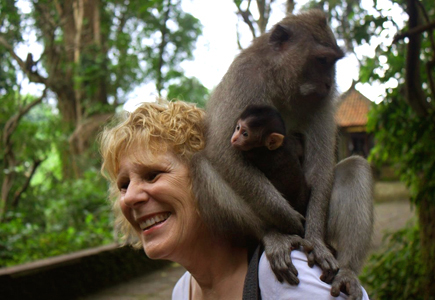
Susan Callery
Managing Editor, NASA’s Global Climate Change Website - NASA's Jet Propulsion Laboratory (JPL)
I am from San Jose, California, although I have lived in Southern California for all of my adult life.
My mother was fascinated with the night sky and knew every constellation in the Northern Hemisphere. Since coming to JPL, I’ve taken up amateur astronomy and have an 8” telescope that I share with my son-in-law.
I ended up in the space program quite by accident. I came to NASA's Jet Propulsion Laboratory (JPL) by way of the Department of Toxic Substances Control (DTSC), which is a department within the California Environmental Protection Agency (EPA.) My role at DTSC was to communicate the scientific information to the public related with the cleanup of toxic sites. With so many changes happening in the California budget, I was looking to find a similar position and found the perfect fit at JPL. The position was perfect because of JPL's diversity: I can work in the field of Earth science and enjoy and learn about space science at the same time.
I started my career at JPL as the Manager of Earth Science Public Engagement, which I carried out for over a decade. During that time, I realized that climate science was my favorite area within Earth Science. Since I’m now in my “senior” years, I’m working part-time as the Manager of climate.nasa.gov. I work with a small, but fantastic team to make climate science as understandable as possible.
I already have so many! I loved working at the Science Bowl, the Ocean Science Bowl, and at the FIRST Robotics competition. It was very inspiring to see so many young people who are interested in and excited about science. I also loved the JPL Open House, which brings together all of JPL's Earth science to show the public how we take the vital signs of our planet from space.
My mother was my greatest inspiration. She had a huge heart and was very generous and caring. I hope she would be proud of me today.
Start much earlier than I did! It took me many years to find my passion. I started in scientific research, went into interior design, went into politics, became a paralegal (which I was terrible at), and then went into environmental science communication and public outreach.
I also went back to school to get a master's degree in environmental policy at the age of 54. This came about from taking a trip to the jungles of Borneo. There I saw the rainforests being destroyed for palm oil plantations. Every day, mother and father orangutans are killed and babies are chained up or sold into the illegal pet trade in the name of palm oil. I returned home to Los Angeles and enrolled in graduate school.
I travel to faraway places, like Borneo, Sumatra, the Amazon, Bali, and Antarctica. I also took up scuba diving in 2009 and I have been diving in Belize and Indonesia.
I am active in various causes, such as rescuing shelter dogs and serving on the board of the Orang Utan Republik Foundation. We are a small foundation that strives to save wild orangutans from extinction through education and outreach programs.
Learn to write and communicate well. Don't forget to lead a balanced, active, fun life -- it will help the scientific part. If you're going into a research career, you have to have passion. My advice for high school students is to get experience, particularly if you live in a community near a university.
Planetary science is a global profession.

